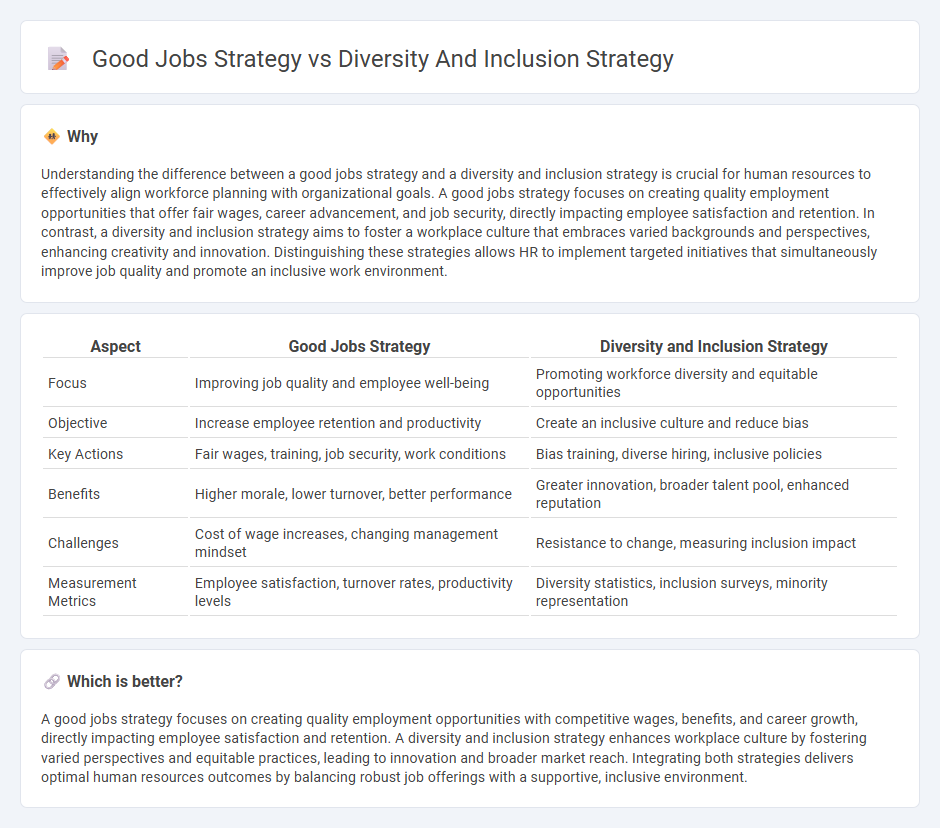
A good jobs strategy focuses on attracting, retaining, and developing talent by offering competitive salaries, clear career paths, and robust training programs. Diversity and inclusion strategies prioritize creating equitable work environments that embrace varied perspectives, ensure equal opportunities, and foster belonging among all employees. Explore how integrating both approaches can maximize organizational performance and innovation.
Why it is important
Understanding the difference between a good jobs strategy and a diversity and inclusion strategy is crucial for human resources to effectively align workforce planning with organizational goals. A good jobs strategy focuses on creating quality employment opportunities that offer fair wages, career advancement, and job security, directly impacting employee satisfaction and retention. In contrast, a diversity and inclusion strategy aims to foster a workplace culture that embraces varied backgrounds and perspectives, enhancing creativity and innovation. Distinguishing these strategies allows HR to implement targeted initiatives that simultaneously improve job quality and promote an inclusive work environment.
Comparison Table
| Aspect | Good Jobs Strategy | Diversity and Inclusion Strategy |
|---|---|---|
| Focus | Improving job quality and employee well-being | Promoting workforce diversity and equitable opportunities |
| Objective | Increase employee retention and productivity | Create an inclusive culture and reduce bias |
| Key Actions | Fair wages, training, job security, work conditions | Bias training, diverse hiring, inclusive policies |
| Benefits | Higher morale, lower turnover, better performance | Greater innovation, broader talent pool, enhanced reputation |
| Challenges | Cost of wage increases, changing management mindset | Resistance to change, measuring inclusion impact |
| Measurement Metrics | Employee satisfaction, turnover rates, productivity levels | Diversity statistics, inclusion surveys, minority representation |
Which is better?
A good jobs strategy focuses on creating quality employment opportunities with competitive wages, benefits, and career growth, directly impacting employee satisfaction and retention. A diversity and inclusion strategy enhances workplace culture by fostering varied perspectives and equitable practices, leading to innovation and broader market reach. Integrating both strategies delivers optimal human resources outcomes by balancing robust job offerings with a supportive, inclusive environment.
Connection
A good jobs strategy enhances workforce quality by attracting and retaining diverse talent, directly supporting effective diversity and inclusion initiatives. Integrating inclusive hiring practices and equitable career development within job strategies fosters a culture where varied perspectives drive innovation and employee engagement. Aligning these strategies ensures organizational resilience, better decision-making, and improved business performance through comprehensive talent management.
Key Terms
**Diversity and Inclusion Strategy:**
Diversity and inclusion strategy emphasizes creating equitable workplaces by fostering representation of varied identities, cultures, and perspectives through policies, training, and inclusive leadership. This approach improves employee engagement, innovation, and company reputation while addressing systemic bias and barriers to opportunity. Explore how targeted diversity and inclusion initiatives can transform organizational culture and drive business success.
Equity
Equity-focused strategies in diversity and inclusion prioritize equal access and fair treatment for underrepresented groups, ensuring systemic barriers are addressed. Good jobs strategies emphasize creating equitable employment opportunities by promoting fair wages, job security, and career advancement for marginalized communities. Explore how integrating these approaches can drive comprehensive workplace equity and sustainable inclusion.
Belonging
A strong diversity and inclusion strategy emphasizes creating a sense of belonging by fostering inclusive cultures where all employees feel valued and respected. A good jobs strategy complements this by ensuring fair wages, job security, and opportunities for career advancement, which enhance employee satisfaction and retention. Discover how integrating belonging into both strategies drives organizational success and employee well-being.
Source and External Links
Sample Diversity and Inclusion Strategy - This strategy provides a roadmap to create an inclusive workplace by fostering diversity in recruitment and promoting a culture of collaboration and fairness.
Creating a Diversity, Equity, and Inclusion Strategy - Offers a comprehensive toolkit for developing a DEI strategy, emphasizing planning and accountability in achieving organizational goals.
What Is a DEI Strategy? - Defines DEI as a four-pillared approach -- Diversity, Equity, Inclusion, and Belonging -- necessary for creating a positive work culture where all employees feel valued.
 dowidth.com
dowidth.com